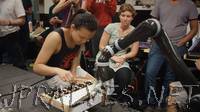
“After learning new software and programming languages, Stanford students in the Artificial Intelligence Laboratory have an opportunity to choose a creative task and design a robot to perform the task for demonstration. The tasks call for a wide range of fundamental skills, but generally require the robot to sense where it is in space, detect objects around it, and then autonomously interact with those objects in its environment. Recent projects include placing dominoes, playing the xylophone, and sketching out an image.”
